In the bustling world of culinary innovation, the industrial panini press has emerged as a game-changer, particularly in Europe and the United States. This compact, efficient kitchen appliance has been transforming the way sandwiches are prepared, offering both chefs and diners a delightful taste experience. As we delve into the intricacies of this market, it’s clear that the industrial panini press is not just a trend—it’s a cornerstone of modern foodservice.
IntroductiontoIndustrialPaniniPresses
Industrial panini presses have emerged as a game-changer in the culinary industry, particularly in the bustling sectors of European and American cafes, restaurants, and fast-food outlets. These innovative machines, designed to effortlessly grill and press a variety of ingredients into a delectable sandwich, have redefined the way food is prepared and presented. Let’s delve into the intricacies of industrial panini presses, exploring their design, functionality, and the impact they have on the foodservice market.
At the heart of an industrial panini press lies its robust build and durable construction. Crafted from high-quality materials, these presses are built to withstand the rigorous demands of commercial kitchens. They are typically equipped with a flat top and a bottom plate that can be adjusted to accommodate different sizes and thicknesses of sandwiches. This versatility ensures that operators can cater to a wide range of preferences and dietary requirements.
One of the standout features of industrial panini presses is their ability to provide consistent results with each use. The even heat distribution and precise pressure control guarantee that every sandwich comes out perfectly toasted and crispy on the outside while remaining juicy and tender on the inside. This level of precision is crucial for maintaining brand consistency and customer satisfaction.
In terms of functionality, industrial panini presses come in various configurations to suit different operational needs. Some models are equipped with adjustable heat settings, allowing operators to tailor the cooking temperature to the specific requirements of their menu items. Others feature timers, which can be set to ensure that sandwiches are cooked to perfection without the risk of burning.
Energy efficiency is another significant advantage of industrial panini presses. These appliances are designed to minimize energy consumption, which not only helps businesses reduce their operational costs but also aligns with the growing demand for eco-friendly practices in the foodservice industry.
The compact design of industrial panini presses is also a major draw for operators. Despite their commercial-grade capabilities, these machines are surprisingly space-saving, making them a practical choice for both small and large kitchens. Their ease of use and maintenance further contribute to their popularity, as they require minimal training for staff to operate effectively.
In Europe, the industrial panini press market has seen considerable growth, driven by a rising trend towards quick-service restaurants and casual dining. The continent’s diverse culinary landscape has fostered a demand for a wide array of sandwiches, from classic ham and cheese to gourmet creations that incorporate exotic flavors and ingredients. Industrial panini presses have become an essential tool for chefs and cooks who want to offer their customers a convenient and delicious meal option.
Similarly, in the United States, the demand for industrial panini presses has surged, especially in the fast-casual segment. The rise of food trucks and the popularity of street food culture have made these machines a staple in many mobile kitchens. Their ability to create a wide range of sandwiches quickly and efficiently has made them a favorite among entrepreneurs looking to set up a new business or expand their menu offerings.
Moreover, the versatility of industrial panini presses has allowed them to be used for more than just sandwiches. Many operators have found creative ways to utilize these appliances to prepare wraps, flatbreads, and even grilled cheese, expanding their menu options and attracting a broader customer base.
As the foodservice industry continues to evolve, the role of industrial panini presses is likely to become even more significant. With the increasing emphasis on convenience, speed, and quality, these machines are poised to become an indispensable part of the modern kitchen. The ongoing innovations in technology and design are expected to bring even more sophisticated features to the market, further enhancing the capabilities of industrial panini presses.
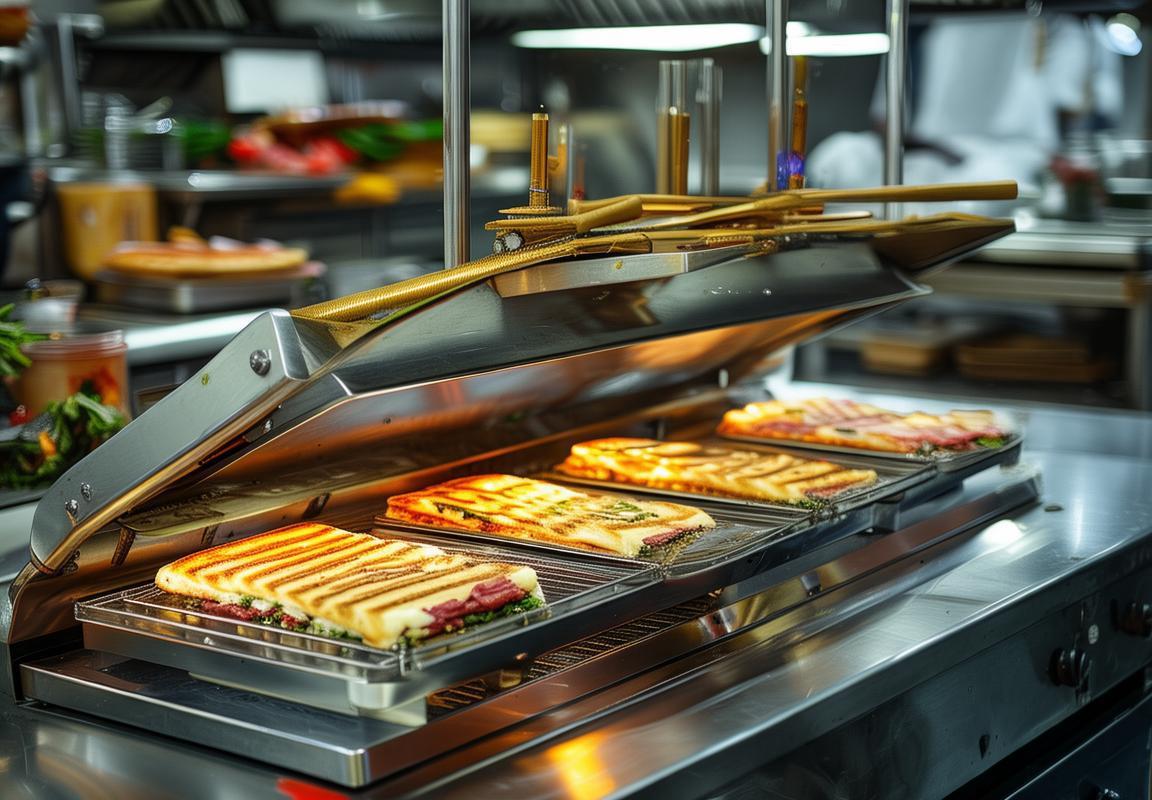
MarketDynamicsinEurope
In the heart of Europe, the market for industrial panini presses has been experiencing a significant surge. These versatile appliances have become a staple in various foodservice establishments, from bustling cafes to busy restaurants. The dynamics driving this market are multifaceted, encompassing consumer trends, technological advancements, and the ever-evolving demands of the industry.
The demand for convenience and speed in food preparation has propelled the popularity of industrial panini presses. As the fast-casual dining sector continues to grow, operators are seeking efficient ways to serve high-quality, freshly cooked sandwiches quickly. This has created a ripe environment for industrial panini presses to shine, offering a solution that can handle large volumes with ease.
Moreover, the European culinary landscape is increasingly diverse, with a variety of ethnic cuisines gaining popularity. Industrial panini presses have become a favorite among foodservice providers looking to offer a range of international dishes, from Italian paninis to Japanese-style gyros. This adaptability has made them a must-have for many operators aiming to cater to a diverse clientele.
Energy efficiency is another key factor influencing the market dynamics. With environmental concerns at the forefront, European businesses are looking for sustainable solutions that reduce their carbon footprint. Industrial panini presses are designed to use less energy than traditional grills or ovens, making them an attractive option for eco-conscious operators.
The competitive landscape is also shaping the market for industrial panini presses. As more manufacturers enter the market, they are pushing the boundaries of innovation, offering features like adjustable heat settings, non-stick surfaces, and compact designs. This competition has led to a wider range of options for businesses, allowing them to choose the perfect press that fits their specific needs.
In terms of distribution, the market for industrial panini presses is well-established. Established distributors and wholesalers are well-versed in the needs of the foodservice industry, ensuring that these presses are readily available to operators across Europe. The ease of procurement has played a significant role in the rapid adoption of industrial panini presses.
Regulatory compliance is a critical aspect of the European market. Manufacturers must adhere to strict safety and health standards, which can sometimes slow down the introduction of new products. However, this also ensures that the industrial panini presses reaching the market are of the highest quality and safety standards.
The pandemic has had a lasting impact on the market dynamics. The shift towards contactless dining and increased focus on hygiene has highlighted the importance of equipment that can maintain high sanitation standards. Industrial panini presses, with their ease of cleaning and quick heat-up times, have become even more valuable in the post-pandemic landscape.
In terms of pricing, the industrial panini press market is competitive, with a wide range of options available to suit different budgets. While higher-end models offer advanced features, there are also cost-effective options that meet the needs of smaller establishments or those on a tight budget.
The future of the European market for industrial panini presses looks promising. As the demand for quick, quality food continues to rise, these presses are well-positioned to capitalize on this trend. The integration of new technologies, such as smart controls and connectivity, could further enhance their appeal to foodservice operators looking to streamline their operations and provide a superior dining experience.
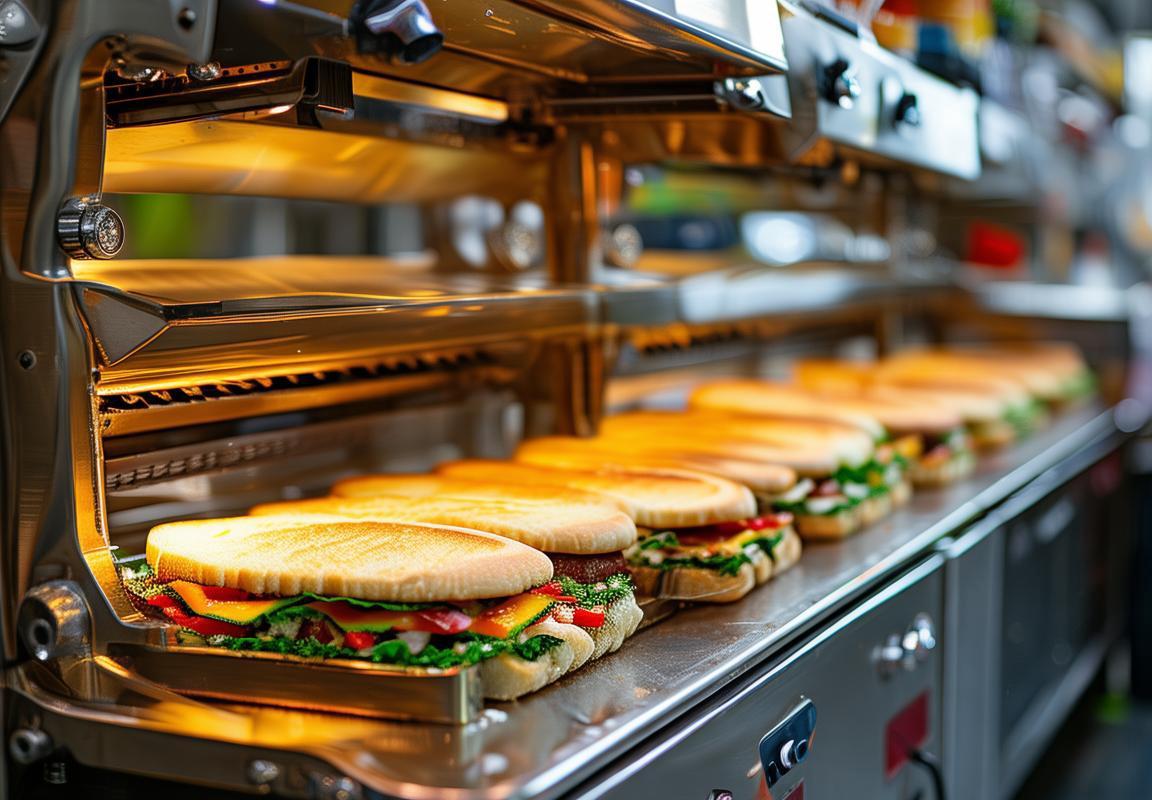
TrendsintheAmericanKitchen
In the United States, the culinary landscape is constantly evolving, and with it, the demand for innovative kitchen appliances. Among these, industrial panini presses have seen a surge in popularity, driven by several key trends that are reshaping the American kitchen.
The rise of fast-casual dining has significantly impacted the market for industrial panini presses. These presses offer a quick and efficient way to prepare high-quality sandwiches, aligning perfectly with the fast-paced nature of fast-casual establishments. As consumers seek convenience without sacrificing quality, these presses have become a staple in many of these venues.
Health and wellness are at the forefront of consumer preferences, and industrial panini presses have capitalized on this trend by offering a healthier alternative to fried foods. Their ability to cook with minimal oil or fat has made them a favorite for preparing grilled sandwiches, wraps, and other healthier fare. This shift towards healthier eating habits has propelled the demand for these versatile appliances.
The rise of gourmet sandwiches has also played a role in the popularity of industrial panini presses. These devices can be used to craft sophisticated and artisanal sandwiches that cater to food enthusiasts looking for unique flavors and textures. From gourmet cheese combinations to creative fillings, the possibilities for customization are endless, appealing to chefs and diners alike.
Technology has been a silent driver behind the trend of industrial panini presses in the American kitchen. Modern presses often come equipped with features like adjustable heat settings, non-stick surfaces, and programmable settings that allow for precise cooking. This technological advancement has made it easier for chefs to produce consistent and high-quality results, enhancing the appeal of these appliances.
The convenience factor cannot be overstated. Industrial panini presses are compact and easy to clean, making them a practical choice for busy kitchens. Their ability to cook multiple sandwiches at once also contributes to their popularity in high-volume operations, where time is of the essence.
The influence of social media and food bloggers has also had a notable impact. As these platforms showcase the artistry and creativity that can be achieved with a panini press, more and more kitchens are investing in these appliances. The visual appeal of beautifully presented sandwiches has sparked a trend that is now influencing the way restaurants and home chefs approach sandwich preparation.
Sustainability is another trend that has influenced the market for industrial panini presses. As businesses look to reduce their carbon footprint, these energy-efficient appliances are becoming more attractive. They consume less power than traditional ovens and grills, making them a more eco-friendly choice.
Lastly, the versatility of industrial panini presses cannot be ignored. They can be used to cook a wide range of foods beyond sandwiches, including pizzas, quesadillas, and even desserts. This versatility ensures that the investment in a panini press can yield a high return on investment for any kitchen.
In conclusion, the trends in the American kitchen have created a fertile ground for the growth of industrial panini presses. From fast-casual dining to health-conscious consumers, the demand for these versatile appliances is on the rise, and it’s clear that they are here to stay.
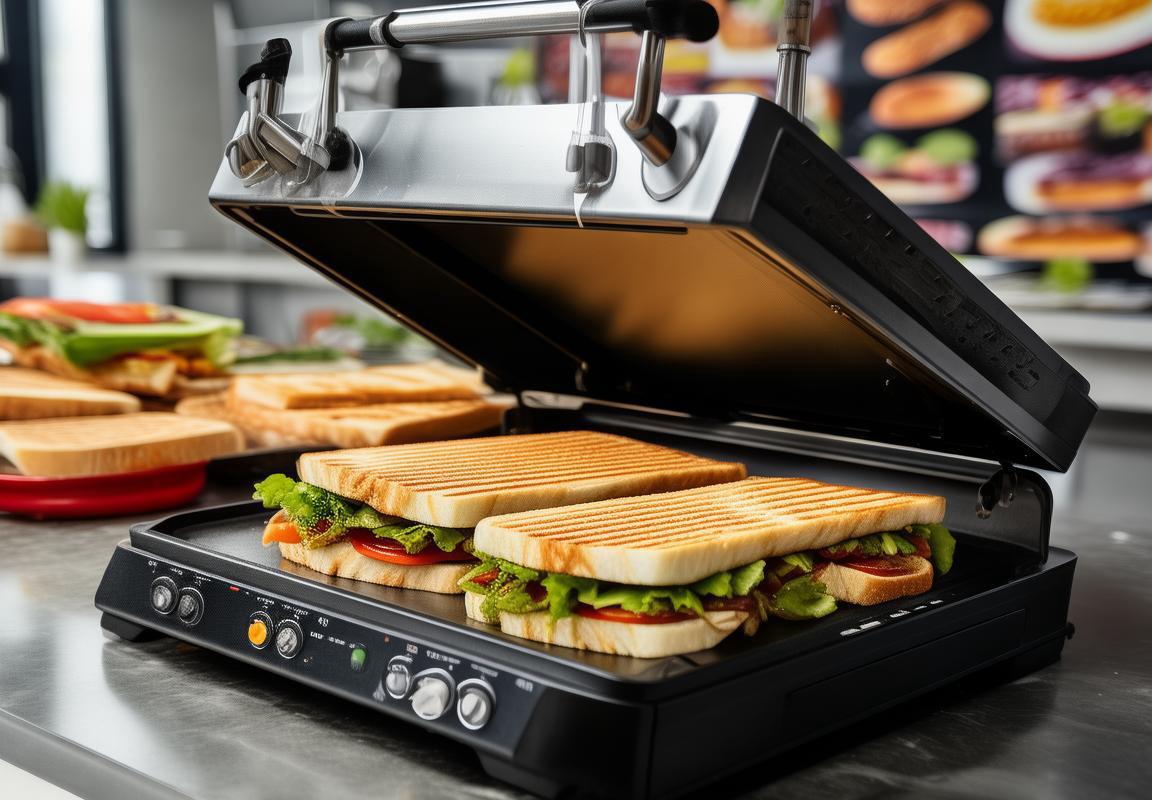
KeyPlayersandInnovations
In the world of industrial panini presses, a few key players have emerged as leaders, driving innovation and setting industry standards. These companies are not just manufacturers but also trendsetters, constantly pushing the boundaries of what these machines can do.
Innovation in DesignOne of the standout innovations comes from companies like GASTRAUCHE, which has redefined the look and feel of industrial panini presses. Their sleek, modern designs not only enhance the aesthetic appeal of commercial kitchens but also improve user experience. The intuitive interfaces and ergonomic controls make these presses a favorite among chefs and kitchen staff.
Functionality Over FormWhile aesthetics are important, functionality is king in the industrial panini press market. Brands like RATIONAL and Nu-Wave have excelled in creating presses that offer a combination of speed, consistency, and versatility. Their machines are designed to handle high volumes with precision, ensuring that every sandwich comes out perfectly toasted and crisp.
Energy EfficiencyWith sustainability becoming a major concern for businesses, energy-efficient industrial panini presses have gained traction. Companies like Breville have integrated smart technology that not only reduces energy consumption but also extends the lifespan of the appliances. These eco-friendly features are increasingly becoming a deciding factor for restaurants looking to minimize their carbon footprint.
Customization and Modular SolutionsTo cater to diverse needs, some key players offer customizable options. For instance, the modular design of presses from Middleby Corporation allows for easy upgrades and modifications. This flexibility is crucial for businesses that anticipate changes in menu offerings or kitchen layout.
Smart Technology IntegrationThe integration of smart technology has been a game-changer. Brands like Hamilton Beach have introduced panini presses with Bluetooth connectivity, allowing for remote monitoring and control. This level of connectivity ensures that kitchen staff can manage cooking times and temperatures without being tied to the machine, enhancing productivity.
Durability and MaintenanceDurability is a hallmark of the key players in the industrial panini press market. Companies like Wolfgang Puck’s Puck Brands focus on building machines that can withstand the rigors of a busy kitchen. The ease of maintenance and the availability of replacement parts are also factors that set these brands apart.
Market ExpansionSeveral key players have expanded their market reach by entering into strategic partnerships and collaborations. For example, Breville has partnered with high-end retailers to offer their industrial panini presses directly to consumers, broadening their customer base beyond the commercial sector.
Innovative Cooking TechniquesBeyond the standard panini, key players are experimenting with new cooking techniques. Some presses now come with dual-zone heating, allowing for the perfect balance of crispy bread and melting cheese. Others have integrated steam functionality for a variety of bread and meat options, including vegan and gluten-free alternatives.
Safety FeaturesSafety is a top priority for these companies, with features like automatic shut-off and temperature control becoming standard. Brands like Sunbeam have implemented safety interlocks that prevent the press from operating if it’s not properly closed, reducing the risk of accidents.
In summary, the key players in the industrial panini press market are not just about making a great product; they’re about creating a comprehensive solution that meets the evolving needs of the kitchen. Through continuous innovation, they are shaping the future of commercial sandwich preparation.
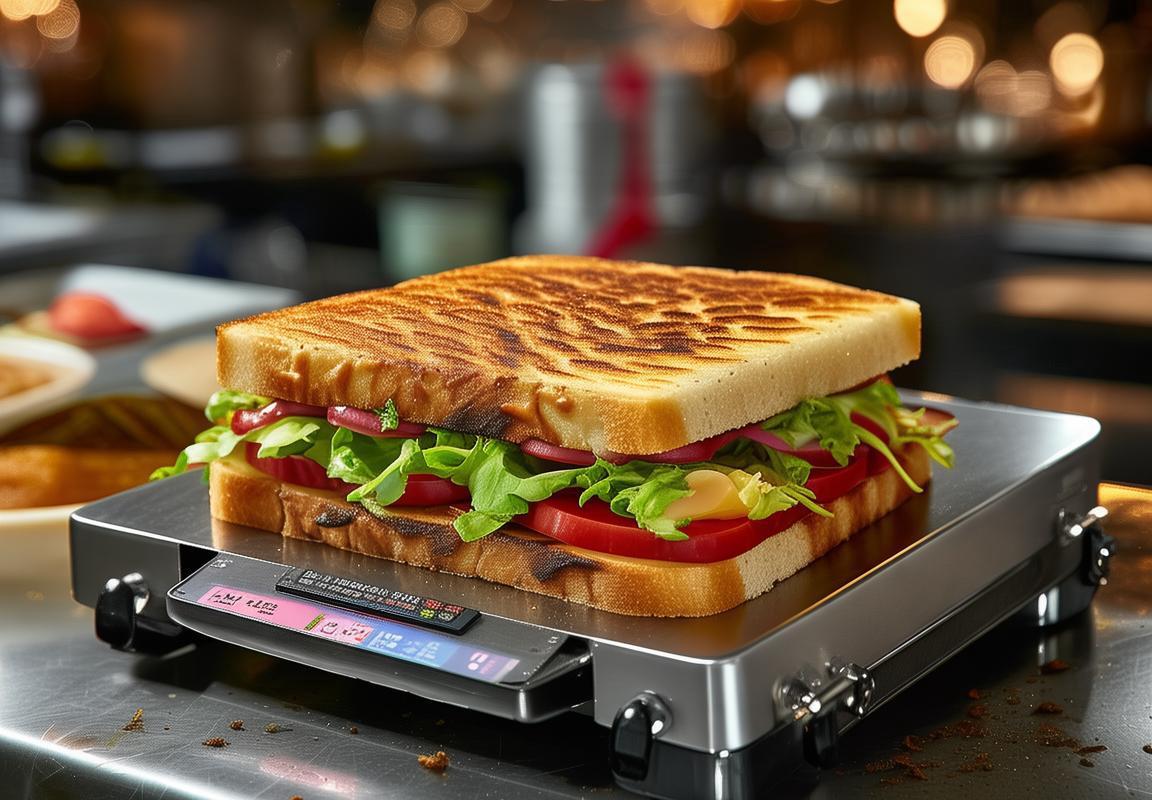
BenefitsofIndustrialPaniniPresses
In the bustling kitchens of Europe and the vibrant eateries across America, industrial panini presses have become more than just a staple; they’re a cornerstone of efficiency and culinary excellence. These versatile appliances have not only transformed the way sandwiches are made but also brought about a host of benefits that are reshaping the foodservice industry.
-
Consistent Cooking ResultsIndustrial panini presses are engineered to deliver uniform heat distribution, ensuring that every sandwich is cooked to perfection. The precise temperature control and even pressure exerted on the food guarantee that the bread is toasted to a golden brown while the fillings are heated thoroughly, without the risk of burning or undercooking.
-
Speed and ProductivityTime is of the essence in the foodservice industry, and industrial panini presses have proven to be a game-changer in terms of speed. These machines can produce a high volume of sandwiches in a short amount of time, reducing wait times for customers and boosting overall productivity in the kitchen.
-
Enhanced Menu VarietyWith an industrial panini press, chefs and kitchen staff can easily expand their menu offerings. From classic ham and cheese to gourmet creations with avocado and pesto, these presses can handle a wide array of ingredients and preparation styles, allowing establishments to cater to diverse tastes and dietary preferences.
-
Energy EfficiencyModern industrial panini presses are designed with energy efficiency in mind. By utilizing less power compared to traditional grills or ovens, these machines help reduce energy costs and have a smaller carbon footprint, making them an environmentally friendly choice for businesses.
-
Enhanced Food SafetyThe compact design of industrial panini presses, along with their ability to cook food at high temperatures, helps to kill bacteria and pathogens, reducing the risk of foodborne illnesses. This feature is particularly crucial in high-risk foodservice environments where food safety is paramount.
-
Easy to Clean and MaintainIndustrial panini presses are designed with ease of cleaning in mind. Most models feature removable parts and non-stick surfaces that make cleanup quick and hassle-free. This not only saves time but also ensures that the presses remain in optimal working condition for extended periods.
-
Attractive PresentationThe visual appeal of a freshly toasted panini is undeniable. The golden brown crust and melted cheese create an inviting presentation that can entice customers and add to the overall dining experience. Industrial panini presses help foodservice operators capitalize on this visual appeal to attract more customers.
-
Versatility in UsageBeyond sandwiches, industrial panini presses can be used to cook a variety of other foods, including wraps, flatbreads, and even small pizzas. This versatility allows kitchens to diversify their offerings without the need for multiple appliances.
-
Customization and BrandingFor businesses looking to differentiate themselves, industrial panini presses offer a unique opportunity for customization. From branding the cooking plates with logos to creating signature designs on the bread, these machines can help establishments create a personalized touch that resonates with their brand identity.
-
Cost-Effective InvestmentWhen considering the long-term benefits, the initial investment in an industrial panini press can be justified by the efficiency gains, reduced energy costs, and increased sales. The return on investment is often seen in the form of higher productivity, customer satisfaction, and an expanded menu that attracts a wider customer base.
In conclusion, the benefits of industrial panini presses in the foodservice industry are multifaceted, offering a combination of efficiency, quality, and versatility that can significantly enhance the overall dining experience. As the demand for high-quality, fast-service food continues to grow, these appliances are poised to remain a key component in the kitchens of Europe and America.
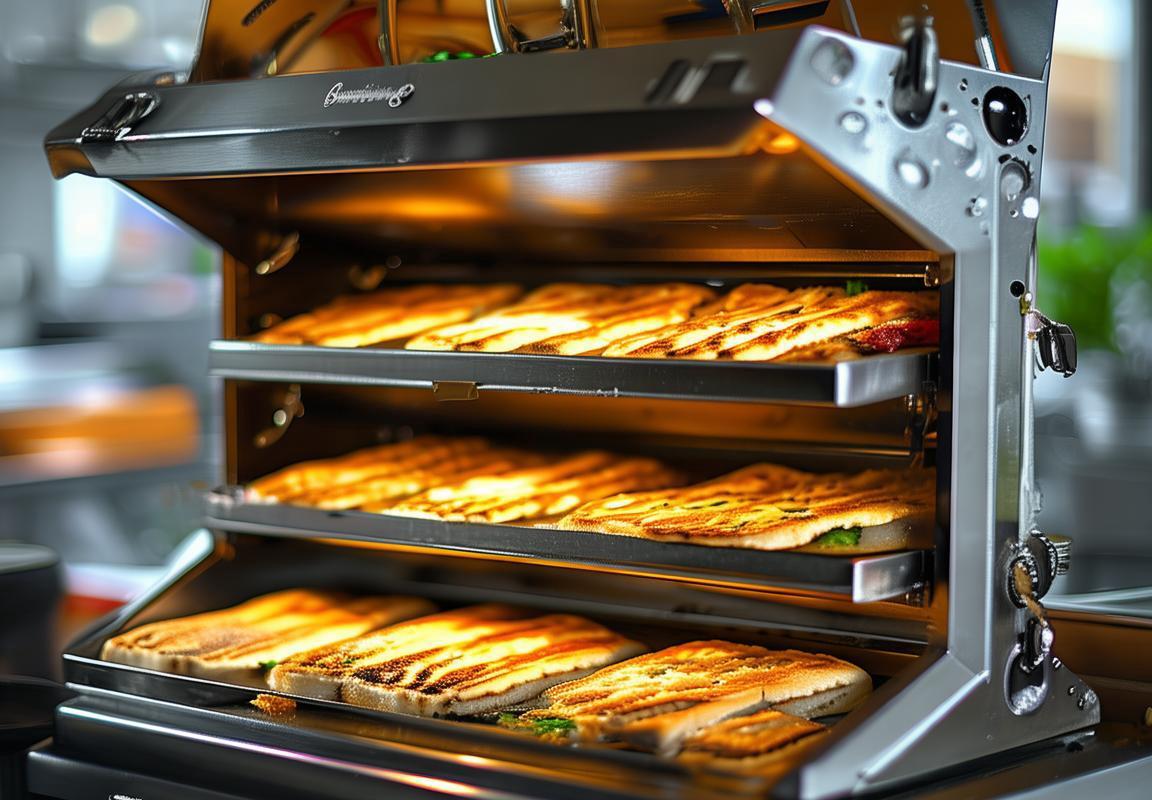
ChallengesandConsiderations
The integration of industrial panini presses into commercial kitchens comes with a set of challenges and considerations that businesses must navigate to ensure seamless operation and customer satisfaction. Here’s a delve into the issues that arise with the adoption of these specialized appliances:
Maintaining Consistency Across High-Volume ProductionIn high-volume environments, the key challenge lies in maintaining consistent quality. Ensuring that every panini comes out with the same level of crispness and flavor profile can be difficult, especially as staff fatigue sets in. Kitchens must invest in training programs to ensure operators are skilled in the nuances of using industrial panini presses effectively.
Addressing Health and Safety ConcernsHealth codes and safety regulations are stringent in the foodservice industry. Industrial panini presses can present unique challenges such as hot surfaces and potential burns. Regular maintenance, clear labeling of hot areas, and the use of protective gear are essential to prevent accidents and comply with health and safety standards.
Handling Diverse Menu ItemsOne of the challenges is the versatility of the menu. While panini presses are perfect for sandwiches, some kitchens may want to use them for various other items like grilled cheese, wraps, or even desserts. Adapting the press to different types of food requires careful selection of materials and coatings to ensure even heating and prevent sticking.
Energy Efficiency and Cost ManagementCommercial kitchens are always looking for ways to reduce operational costs. Industrial panini presses can be energy-intensive, so it’s crucial to choose models that offer energy-saving features. Additionally, monitoring and managing the energy consumption of these appliances is key to maintaining a cost-effective operation.
Regular Cleaning and MaintenanceTo prevent the build-up of residue and bacteria, industrial panini presses require frequent cleaning. This task can be time-consuming and labor-intensive. Kitchens must develop efficient cleaning protocols that minimize downtime and maintain the longevity of the equipment.
Staff Training and AdaptabilityThe staff must be well-trained to use the panini press effectively. This includes understanding how to adjust heat settings, manage cooking times, and troubleshoot common issues. As kitchen staff turnover can be high, ongoing training programs are necessary to maintain consistency in the preparation of panini and other grilled items.
Space OptimizationIndustrial panini presses can be quite large and may not fit comfortably into every kitchen layout. Finding the right spot for the press without compromising on workflow or creating a bottleneck is a significant consideration. Kitchens must carefully plan their layouts to ensure the press integrates seamlessly with the rest of the equipment.
Menu Adaptation and InnovationThe popularity of panini-style sandwiches often leads to menu iteration. Kitchens must consider how the panini press fits into their menu strategy, whether it’s offering a variety of fillings or creating unique recipes. This requires a balance between adhering to established standards and experimenting with new ideas.
Customer Expectations and SatisfactionUltimately, the goal is to meet or exceed customer expectations. This means that the panini press must consistently deliver high-quality results. Any issues with the press, such as uneven cooking or cold spots, can lead to disappointed customers. Regular performance checks and prompt repairs are essential to maintain customer satisfaction.

ConsumerPreferences
In the world of fast-casual dining, consumer preferences have shifted towards convenience, health, and flavor, with panini presses playing a pivotal role in satisfying these demands. Here’s a closer look at what drives these preferences:
-
Convenience and SpeedConsumers are increasingly looking for quick meal options that don’t compromise on taste or quality. Panini presses offer a fast and efficient way to prepare sandwiches, which is particularly appealing to busy individuals and families on the go.
-
Customization and PersonalizationModern consumers value the ability to customize their meals. Panini presses allow for a variety of fillings and toppings, giving customers the freedom to create their perfect sandwich, which is a significant draw for those who enjoy a tailored dining experience.
-
Visual AppealThe distinctive golden-brown crust and melty cheese that panini presses provide make for visually appealing sandwiches. The presentation of a freshly made panini can be a significant factor in attracting customers, especially in the competitive foodservice industry.
-
Health ConsciousnessAs health and wellness become more important, consumers are gravitating towards sandwiches that offer a balance of protein, vegetables, and whole grains. Panini presses can accommodate a wide range of healthy ingredients, making them a preferred choice for those looking to eat more nutritiously.
-
Versatility in Menu OfferingsPanini presses are not just for sandwiches; they can also be used to cook a variety of other items like wraps, flatbreads, and even pizzas. This versatility allows restaurants to expand their menu options and cater to a broader audience.
-
Social Media and InfluencersThe rise of social media has had a profound impact on consumer preferences. Influencers and food bloggers often showcase their culinary creations, and panini presses have become a popular tool for creating shareable content. The visual appeal and ease of use make them a favorite among these content creators.
-
Cultural InfluenceCultural trends also play a role in shaping consumer preferences. The Italian influence on panini sandwiches has made them a staple in many countries, and the nostalgia associated with these sandwiches can attract a wide demographic.
-
Environmental ConsiderationsWith growing concerns about sustainability, consumers are looking for businesses that adopt eco-friendly practices. Panini presses often use less energy than traditional grills and ovens, which can be a selling point for environmentally conscious customers.
-
Quality over QuantityIn the age of fast food, consumers are seeking higher quality ingredients and better preparation techniques. The use of a panini press can signify a commitment to quality, as it allows for precise cooking and better control over the sandwich’s texture and flavor.
-
Price SensitivityDespite the premium feel of panini sandwiches, consumers are still price-sensitive. The affordability of panini presses, combined with the ability to produce a high-quality product, makes them an attractive investment for foodservice operators looking to offer a value-driven menu item.
The interplay of these factors has solidified the panini press as a favorite among consumers, driving the demand for these versatile appliances in the American kitchen.
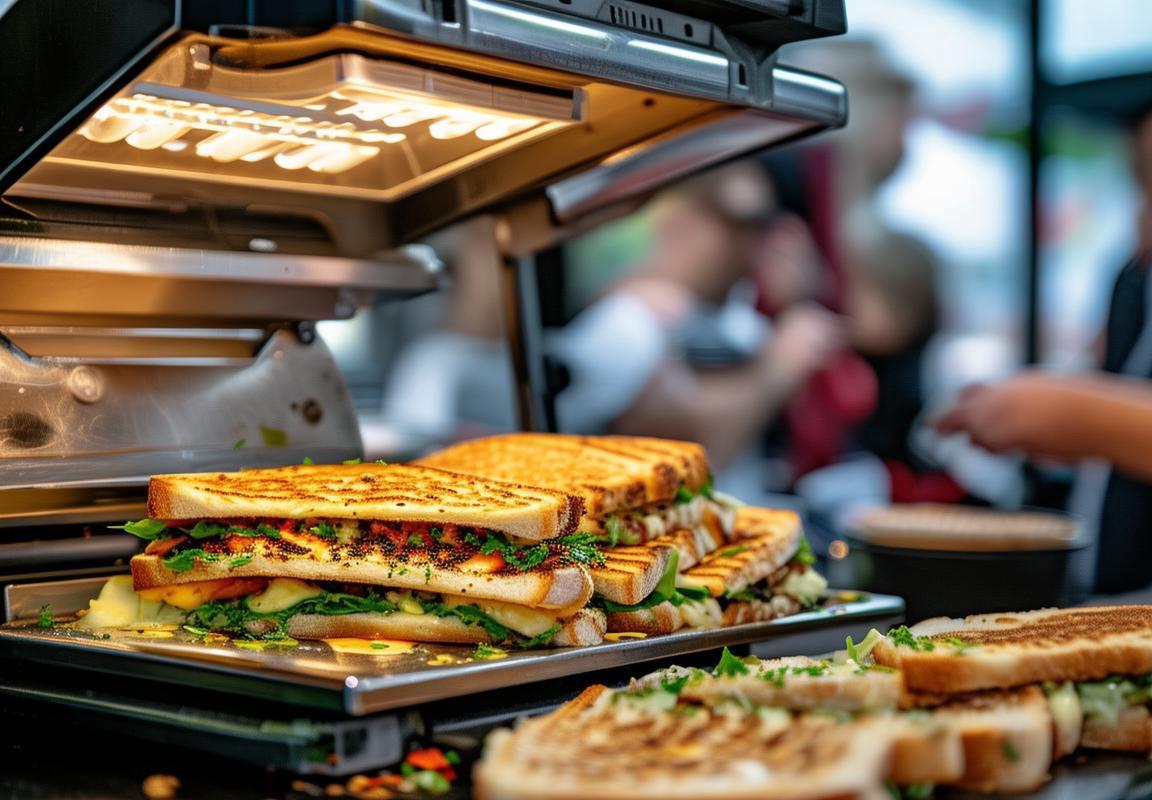
FutureOutlook
In the ever-evolving landscape of the foodservice industry, the future of industrial panini presses appears to be as dynamic as the trends that drive their demand. Here are some key aspects that shape the outlook for this segment:
The increasing popularity of portable and efficient cooking solutions has led to a surge in demand for industrial panini presses. These compact machines are becoming a staple in food trucks, cafes, and quick-service restaurants, offering a convenient way to serve high-quality sandwiches quickly and consistently.
The integration of smart technology in industrial panini presses is set to revolutionize the way these machines are used. With features like remote monitoring, automated temperature control, and predictive maintenance, operators can ensure that their presses are always in optimal condition, reducing downtime and enhancing productivity.
Sustainability is a growing concern for consumers and businesses alike. As such, the future of industrial panini presses may see an emphasis on eco-friendly materials and energy-efficient designs. This shift could not only appeal to environmentally conscious customers but also lower operational costs for businesses.
Health and wellness trends continue to shape consumer preferences, and industrial panini presses can adapt to this by offering a variety of settings that allow for customizing the cooking temperature and pressure. This versatility means that operators can cater to different dietary needs, from low-carb to gluten-free options.
The rise of food delivery services has expanded the market for industrial panini presses. As more people opt for home delivery, the need for these presses to produce high-quality sandwiches that can withstand transportation without compromising on taste or texture will become increasingly important.
Cross-cultural influences are likely to play a role in the future of industrial panini presses. As foodservice operators look to diversify their menus, they may incorporate international flavors into their panini offerings, requiring presses that can handle a wider range of ingredients and cooking techniques.
The emergence of subscription-based services for industrial panini presses could be a significant trend. Operators might prefer a subscription model that includes regular maintenance, cleaning supplies, and replacement parts, making it easier to manage their equipment and reduce downtime.
Regulatory changes and food safety standards are also factors that will influence the future of industrial panini presses. As these standards evolve, manufacturers will need to ensure that their products meet the latest requirements, which may include enhanced safety features and materials.
The rise of gourmet and artisanal food markets is another area that could impact the industrial panini press market. High-end restaurants and specialty shops may seek out presses that can produce unique, high-quality sandwiches that reflect their brand’s commitment to excellence.
In conclusion, the future of industrial panini presses is poised to be shaped by technological advancements, sustainability concerns, health trends, delivery services, cultural influences, subscription models, regulatory changes, and the gourmet food movement. As these factors intertwine, the industry will likely see continued innovation and growth in the demand for these versatile cooking solutions.

Conclusion
The industrial panini press market has seen a surge in popularity, and as it continues to grow, it’s crucial to understand the various factors that contribute to its success. From the consumer’s perspective, the appeal of these versatile machines lies in their ability to deliver consistent, high-quality results time after time. Let’s delve into the factors that influence consumer preferences in the panini press market.
Consumers are increasingly seeking convenience and speed in their meal preparation. The panini press offers a quick and easy way to cook a variety of dishes, from classic sandwiches to gourmet melts. Its compact design and ease of use make it a convenient choice for busy individuals or those looking to streamline their cooking process.
Moreover, the panini press’s versatility is a major draw for consumers. It can cook a range of foods, from sandwiches to grilled vegetables and even pizza. This versatility means that the panini press can be used to create a diverse menu, catering to different tastes and preferences. The ability to customize the cooking process, such as adjusting the heat level and cooking time, also adds to its appeal.
Another significant factor is the quality of the food produced by the panini press. The even heat distribution ensures that the food is cooked thoroughly and uniformly, resulting in a delicious and satisfying meal. The press’s ability to create a crispy outer layer while keeping the inside tender is particularly appealing to consumers who enjoy a good texture in their food.
In today’s health-conscious world, the panini press also offers a healthier alternative to deep-fried or baked foods. Its ability to cook without adding excessive oil or fat makes it a more nutritious choice. Consumers who are looking to incorporate more whole grains and lean proteins into their diet find the panini press to be a valuable tool in their kitchen.
The convenience of clean-up is another aspect that consumers appreciate. The non-stick surfaces of many panini presses make it easy to remove food particles, and the compact size means that the press can be quickly stored away, saving counter space.
Lastly, the panini press’s ability to create a unique dining experience cannot be overlooked. The process of cooking and pressing a sandwich can be fun and interactive, especially for families or groups of friends. The visual appeal of the finished product, with its golden-brown crust and melted cheese, can be a delightful part of the meal experience.
As the market for industrial panini presses continues to expand, it’s clear that consumer preferences are playing a significant role in shaping the industry. The convenience, versatility, quality, health benefits, ease of cleaning, and the unique dining experience that these machines offer are all contributing factors to their growing popularity. As technology advances and new features are introduced, it’s likely that these preferences will evolve, but the panini press’s core appeal remains unchanged—its ability to deliver delicious, homemade-style meals in a fraction of the time.